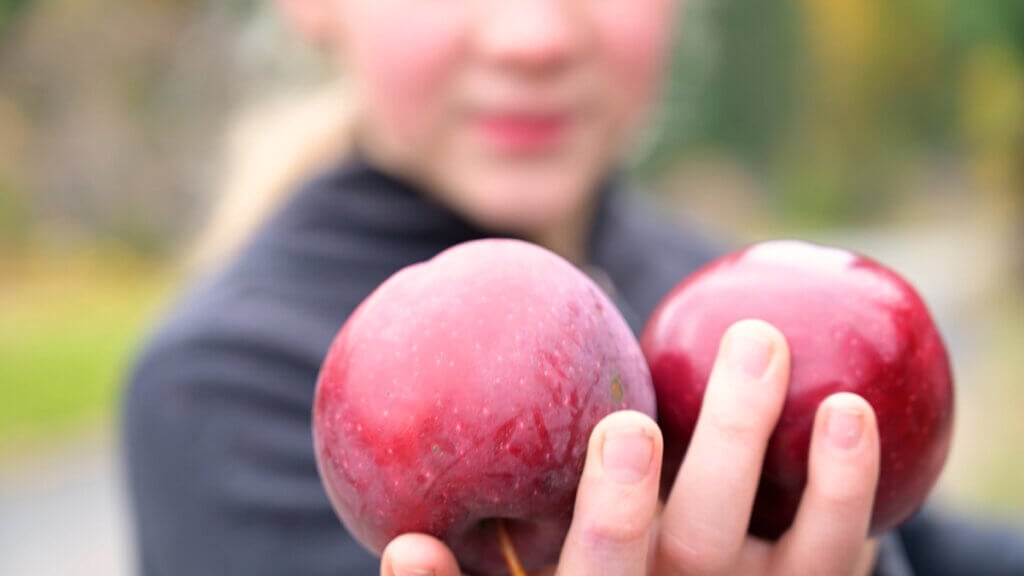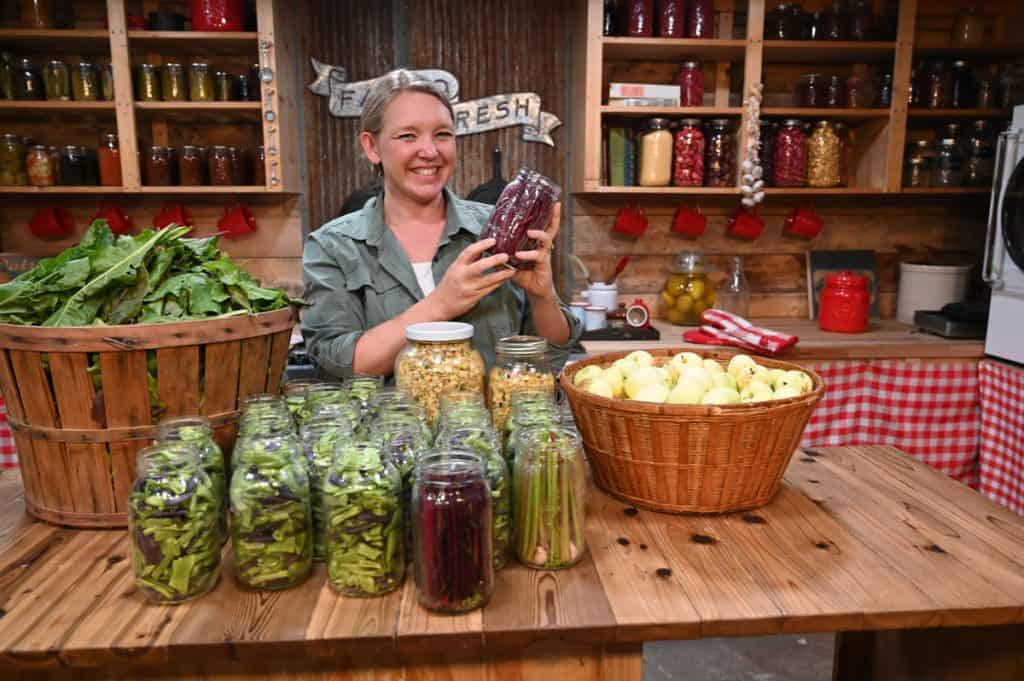As we approach apple season in September and October, it’s important to know how to properly store your apples for long-term freshness. Whether you’ve gone apple picking or picked up some apples at the grocery store, follow our method for storing apples to ensure your apples stay fresh and crisp for months to come.

When it’s apple season, we like to squeeze out as many different preservation methods possible. We make homemade apple scrap vinegar, apple sauce, sparkling apple cider, homemade canned apple pie filling, caramel apples, dehydrated apples, freeze-dried apples and even apple-jalapeno sauerkraut.
For the remainder of our apples, we like to store them for long-term winter eating. There’s nothing like a fresh, crisp apple in the middle of winter to make it feel just a little more like summer!
Table of Contents
ToggleApple Variety is Key
When choosing the best storage method, selecting the right apple varieties is essential. Some apple varieties are better suited for long-term storage than others. Varieties with thick skins, like Granny Smith, Honeycrisp, Braeburn, Rome, or Northern Spy, can last up to six months in proper storage conditions.
Our apples are Red Delicious apples. They’re crisp and firm and are great for long-term storage. In fact, they don’t reach their full sweetness until after they’ve both gone through a frost and sat in storage for at least a few weeks.

Experiment with Different Apple Varieties
It’s worth noting that not all apple varieties are created equal when it comes to long-term storage. Some varieties, like Honeycrisp and Red Delicious, can last up to 6 months when stored properly, while others may only last a few weeks.
Experimenting with different varieties can lead to discovering your new favorite apple and discovering which varieties are best suited for your long-term storage needs.

Tips for Apples that Store Longer
If you want to keep your apples fresh and crisp, it is important to store them correctly. Here are some tips on the best way to store fresh apples:
- No Bruising – When picking apples for long-term storage, it’s very important that they don’t get bruised. Avoid harvesting the windfall apples, or any apples that drop while picking. Set those apples aside and use them for fresh eating right away, not for long-term storage. Homesteading Hack: We save our fallen apples and use a steam juicer to make homemade cider.
- No Nicks or Scrapes – Another useful tip for keeping apples fresh is to avoid cutting them or nicking the skins. Cut apples release ethylene gas, which can speed up the ripening process and cause them to spoil faster.
- No Leaves – Next, if you pick an apple that still has some leaves on it, remove the leaves so they don’t start rotting in storage.
- Proper Temperature – Finally, apples freeze at about 26°F. You want to allow them to go through a couple of light frosts, but you need to keep an eye on the forecast and harvest them before the temperatures drop too much. You don’t want your apples to freeze prior to long-term storage.
Homesteading Hack: When picking apples, be sure to handle them carefully. We like to use this fruit harvesting tool for gently picking the fruit up high in the trees.

How to Store Apples in a Cooler
One of the most common debates regarding apple storage is whether to refrigerate apples or leave them at room temperature. Both methods have advantages and disadvantages, which is why we settled on our cooler method that takes the best of both methods and combines them.
Here’s how to properly store apples in coolers for long-term storage:
- Start by harvesting all your apples, being careful not to let them fall to the ground or get bumped, bruised, or nicked.
- Look over each apple to make sure it’s in good storage condition, removing any leaves from the stem while keeping the stem intact (it’s best to keep the stems on).
- Carefully layer apples into the cooler. It’s OK for the apples to touch, just try to avoid any bruising in the process.
- Once the coolers are full, transport them to an uninsulated garage and place the lid on top but don’t close it. It’s important that the apples get airflow. You also want to avoid condensation forming on the inside of the cooler with nowhere to escape, as this can promote mold. Homesteading Hack: If you don’t have strong able-bodied people to carry the coolers, you may want to have your coolers in place prior to filling as they do get heavy!
We’ve successfully stored our fresh apples using the cooler method from October to the end of March. If you’re in need of some apple-specific coolers, this Coleman Cooler with wheels and handle or this Igloo Cooler with wheels and handle are two great options.
Now, as the saying goes, “One bad apple spoils the whole bunch.” Be sure to periodically check your apples to make sure there are no signs of rotting. If you do see a bad apple, be sure to remove it and any apples around it that are showing signs of bruising or rotting.

Three Methods for Storing Apples
| Method | Advantages | Disadvantages |
|---|---|---|
| Cool and Dark Storage | – Keeps apples fresh and crisp. – Prevents premature ripening. | – Lack of ventilation may cause mold. – Can be difficult to maintain temperature and humidity levels. |
| Refrigeration | – Slows down ripening process. – Apples last longer in the fridge. | – Apples may absorb flavors of other foods in the fridge. – Apples can become soft and mealy if kept in the fridge for too long. |
| Cooler (Best of Both Worlds) | – Keeps apples fresh and crisp. – Prevents premature ripening. – Doesn’t cost money or take up refrigerator space. | – High volume of apples makes it harder to see if there’s a “bad apple” at the bottom of the bunch. – Takes up quite a few coolers (though we don’t see this as a disadvantage, some might). |

The Benefits of Refrigerating Apples
Refrigerating apples is the preferred method for those who want their apples to retain their crispness and freshness for a longer period. The cool temperature slows down the natural ripening process of the apple and helps to preserve its moisture content.
Keeping apples in the refrigerator also prevents them from producing ethylene gas, which is a natural byproduct that accelerates ripening and can cause neighboring fruits and vegetables to spoil faster.
If you choose to refrigerate your apples, store them in the crisper drawer to maintain optimal temperature and humidity levels. Be sure to keep them separate from other fruits and vegetables, especially those that produce ethylene gas, such as bananas, tomatoes, and avocados.
While you can store produce long-term without a root cellar, a root cellar is an excellent option for storing apples, as it offers cool and dark conditions.

The Drawbacks of Refrigerating Apples
While refrigeration can help to extend the freshness of your apples, it can also affect their flavor and texture. Apples stored in the refrigerator may develop a mealier texture and lose some of their natural sweetness.
Additionally, unless you place your apples in a tightly sealed container, they may absorb unwanted flavors and odors from other stored foods.
And finally, with the number of apples we’re wanting to store, we’d need an entire refrigerator dedicated to storing apples. We neither have this space nor want to pay for the utilities of running that refrigerator when we have a better option.
Leaving Apples at Room Temperature
Leaving apples out at room temperature is an ideal option for those who prefer a softer and juicier texture. Apples stored at room temperature will continue to ripen and may become sweeter and more flavorful over time. However, this method is not recommended for long-term storage as apples stored at room temperature have a shorter shelf life and are prone to spoilage.
If you choose to leave your apples at room temperature, store them in a cool and dark place, away from direct sunlight and heat sources. You can also use paper bags to help absorb moisture and prevent apples from bruising.

The Effect of Ethylene Gas on Apple Storage
One critical aspect of apple storage is the role of ethylene gas. Apples naturally produce ethylene gas, which triggers the ripening process. If apples are stored with other fruits and vegetables, the ethylene gas they produce can cause neighboring produce to ripen and spoil faster.
If you want to keep your apples fresh for an extended period, it’s crucial to keep them separate from other produce, especially those that produce high levels of ethylene gas, as mentioned above.
Homesteading Hack: You can use this knowledge of ethylene gas to your benefit. For example, if you have an avocado that you want to ripen as fast as possible, place the avocado and an apple together in a brown paper bag. Fold the bag over and leave it at room temperature and your avocado will ripen more quickly.

Conclusion
When it comes to storing apples, there is no one-size-fits-all approach. The decision between refrigeration, room temperature or our cooler method ultimately depends on your preference, storage options, and the desired texture and flavor of the apple.
Just remember to keep apples separate from other produce and monitor them regularly to ensure they don’t spoil. By following these tips, you can make the most of apple season and enjoy fresh, crisp apples all winter long. Happy apple picking!

Frequently Asked Questions
Apples can be stored for up to six months if stored properly in cool and dark conditions.
It depends on your preference. Refrigerating apples can prolong their freshness while storing them at room temperature allows them to ripen naturally. Fresh apples will be best when eaten within a week or two, while long-term storage options can prolong their life much longer.
It is best to store apple varieties separately, as some varieties release more ethylene gas, which can cause nearby apples to ripen or spoil faster.
Look for apples with thick skins, as these tend to last longer in storage. Avoid apples with any signs of bruising or rot, as they can spoil other apples.
Cut apples are best consumed within a day or two. To prevent browning, soak cut apples in a mixture of lemon juice and water before storing them in an airtight container in the refrigerator.
Paper bags can help absorb excess moisture and reduce the risk of rot. However, they are not mandatory for apple storage.

More Posts You May Enjoy
- Preserving Day Tips for Less Overwhelm
- Preparing Your Pantry for Preserving Season
- How to Get Ready for Preservation Season
- Preservation Tools on a Budget
- Food Preservation Calendar: A Year at a Glance
- Fermentation for Long-Term Preservation
- Preservation 101: Fermenting
- Preservation 101: Root Cellaring
- Preservation 101: Dehydrating


















